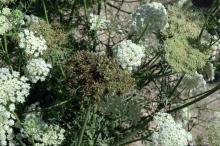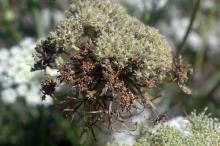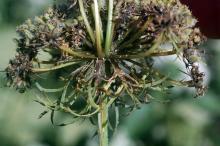Cause Xanthomonas hortorum pv. carotae (syn X. campestris pv. carota) is a bacterium that can be particularly damaging to carrot seed crops. The pathogen can be transmitted in or on seed and can also survive in diseased plant debris. Xanthomonas is spread by wind-blown rain, splashing of irrigation water, or mechanically by insects. Warm, wet conditions favor disease development.
Symptoms Leaf symptoms start as small, irregular, yellow areas, which later turn to irregular, water-soaked, brown lesions. The lesion is surrounded by an irregular yellow halo, and the center becomes dry and brittle. Linear, dark brown lesions on petioles and stems may appear, sometimes with gummy bacterial exudate. Umbels may be partially or completely blighted. Seed yield and quality may be adversely affected.
Cultural control
- Plant healthy seed.
- Treating seed in water at 122°F for 30 min. is effective.
- Use a 2- to 3-year crop rotation.
- Plow down carrot refuse promptly after harvest.
Chemical control
- Cueva (Group M1) at 0.5 to 2 gal/100 gal water on 7- to 10-day intervals. May be applied on the day of harvest. 4-hr reentry. O
- ManKocide (Group M1 + M3) at 2.5 lb/A on 7- to 14-day intervals. Do not apply in a solution having a pH less than 6.5. For use on carrots grown for seed only in Oregon, Washington, and Idaho (SLN ID-020016, SLN OR-170003A&B, and SLN WA-030030). 48-hr reentry.
- Regalia (Group P5) at 1 to 4 quarts/A plus another fungicide on 7- to 10-day intervals. Does not benefit from the addition of an adjuvant. Preharvest interval is 0 days. 4-hr reentry. O
Biological control
- Double Nickel LC at 1 to 6 quarts/A on 3- to 10-day intervals. Can be applied the day of harvest. 4-hr reentry. O
- Serenade Opti at 14 to 20 oz/A on 7- to 10-day intervals. Applications can be made up to and the day of harvest. 4-hr reentry. O
Reference du Toit, L.J., Crowe, F.J., Derie, M.L., Simmons, R.B., and Pelter, G.Q. 2005. Bacterial blight in carrot seed crops in the Pacific Northwest. Plant Disease 89:896-907.



